Sony DSR-20-20P User Manual

3-861-406-14(1)
Digital
Videocassette
Recorder
Operating Instructions page 1EN |
|
EN |
|
|
|
||
Before operating the unit, please read this manual |
|
||
thoroughly and retain it for future reference. |
|
||
|
|
|
|
Mode d’emploi page 1F |
|
F |
|
|
|
||
Avant la mise en service de cet appareil, prière de lire |
|
||
attentivement ce mode d’emploi que l’on conservera |
|
||
pour toute référence ultérieure. |
|
||
DSR-20/20P
1998 by Sony Corporation
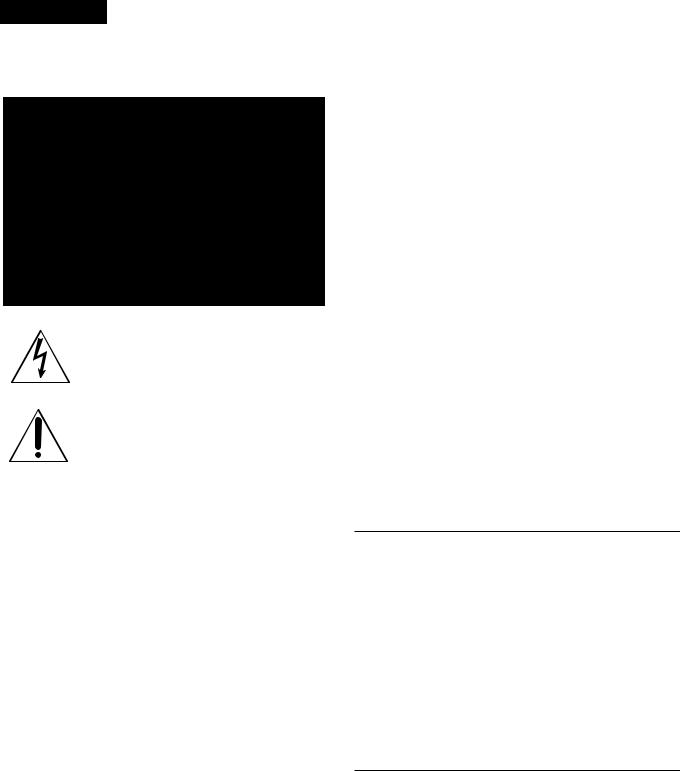
For DSR-20
WARNING
To prevent fire or shock hazard, do not expose the unit to rain or moisture.
This symbol is intended to alert the user to the presence of uninsulated “dangerous voltage” within the product’s enclosure that may be of sufficient magnitude to constitute a risk of electric shock to persons.
This symbol is intended to alert the user to the presence of important operating and maintenance (servicing) instructions in the literature accompanying the appliance.
For the Customers in the U.S.A.
Note:
This equipment has been tested and found to comply with the limits for a Class B digital device, pursuant to Part 15 of the FCC Rules. These limits are designed to provide reasonable protection against harmful interference in a residential installation. This equipment generates, uses, and can radiate radio frequency energy and, if not installed and used in accordance with the instructions, may cause harmful interference to radio communications. However, there is no guarantee that interference will not occur in a particular installation. If this equipment does cause harmful interference to radio or television reception, which can be determined by turning the equipment off and on, the user is encouraged to try to correct the interference by one or more of the following measures:
•Reorient or relocate the receiving antenna.
•Increase the separation between the equipment and receiver.
•Connect the equipment into an outlet on a circuit different from that to which the receiver is connected.
•Consult the dealer or an experienced radio/TV technician for help.
The shielded interface cable recommended in this manual must be used with this equipment in order to comply with the limits for a digital device pursuant to Subpart B of Part 15 of FCC Rules.
Precautions
Safety
•Operate the unit only on 120 V AC, 60 Hz .
•If anything falls into the cabinet, unplug the unit and have it checked by qualified personnel before operating it any further.
•Unplug the unit from the wall outlet if you do not intend to use it for an extended period of time. To disconnect the cord, pull it out by the plug, never by the cord.
Installing
•Allow adequate air circulation to prevent internal heat buildup.
•Do not place the unit on surfaces (rugs, blankets, etc.) or near materials (curtains, draperies) that may block the ventilation slots.
•Do not install the unit near heat sources such as radiators or air ducts, or in a place subject to direct sunlight, excessive dust, mechanical vibration or shock.
•Do not install the unit in an inclined position. It is designed to be operated in a horizontal position only.
•The unit is not designed for portable use. Install it properly on a flat stable place. Placing it on its side or on a surface slanted more than 30 degrees may cause damage.
•Keep the unit and cassettes away from equipment with strong magnets, such as microwave ovens or large loudspeakers.
•Do not place heavy objects on the unit.
•If the unit is brought directly from a cold to a warm location, moisture may condense inside the VCR and cause damage to the video head and tape. When you first install the unit, or when you move it from a cold to a warm location, wait for about one hour before operating the unit.
Information
Compatible color systems
The DSR-20 is designed to record and play back using the NTSC color system. Recording of video sources based on other color systems cannot be guaranteed.
Caution
Television programs, films, video tapes and other materials may be copyrighted. Unauthorized recording of such material may be contrary to the provisions of the copyright laws. Also, use of this recorder with cable television transmission may require authorization from the cable television transmission and/or program owner.
Owner’s record
The model number is located at the rear and front of the unit and the serial number on the top. Record the serial number in the space provided below. Refer to these numbers whenever you call upon your Sony dealer regarding this product.
Model No. DSR-20 Serial No. ______________________
iiEN

For DSR-20P
WARNING
To prevent fire or shock hazard, do not expose the unit to rain or moisture.
To avoid electrical shock, do not open the cabinet. Refer servicing to qualified personnel only.
For the customers in Europe
This product with the CE marking complies with both the EMC Directive (89/336/EEC) and the Low Voltage Directive (73/23/EEC) issued by the Commission of the European Community.
Compliance with these directives implies conformity to the following European standards:
•EN60065: Product Safety
•EN55103-1: Electromagnetic Interference (Emission)
•EN55103-2: Electromagnetic Susceptibility (Immunity) This product is intended for use in the following Electromagnetic Environment(s):
E1 (residential), E2 (commercial and light industrial), E3 (urban outdoors) and E4 (controlled EMC environment, ex. TV studio).
Caution
Television programmes, films, video tapes and other materials may be copyrighted. Unauthorised recording of such material may be contrary to the provisions of the copyright laws. Also, use of this recorder with cable television transmission may require authorisation from the cable television transmitter and/or programme owner.
Compatible colour systems
The DSR-20P is designed to record and play back using the PAL colour system. Recording of video sources based on other colour systems cannot be guaranteed.
For the customers in the Netherlands
Voor de klanten in Nederland
Bij dit produkt zijn batterijen geleverd. Wanneer deze leeg zijn, moet u ze niet weggooien maar inleveren als KCA.
Precautions
Safety
•This unit operates on 220 – 240 V AC, 50 Hz. Check that the unit’s operating voltage is identical with your local power supply.
•If anything falls into the cabinet, unplug the unit and have it checked by qualified personnel before operating it any further.
•The unit is not disconnected from the mains as long as it is connected to the mains outlet, even if the unit itself has been turned off.
•Unplug the unit from the wall outlet if you do not intend to use it for an extended period of time. To disconnect the cord, pull it out by the plug, never by the cord.
Installing
•This unit is equipped with a fan at the rear. Do not insert objects nor touch the fan during operation.
•To prevent internal heat buildup, install the unit at least 5 cm away from the wall, and dust the unit periodically.
•Do not place the unit on surfaces (rugs, blankets, etc.) or near materials (curtains, draperies) that may block the ventilation slots.
•Do not install the unit near heat sources such as radiators or air ducts, or in a place subject to direct sunlight, excessive dust, mechanical vibration or shock.
•The unit is not designed for portable use. Install it properly on a flat stable place. Placing it on its side or on a surface slanted more than 30 degrees may cause damage.
•Keep the unit and cassettes away from equipment with strong magnets, such as microwave ovens or large loudspeakers.
•Do not place heavy objects on the unit.
•If the unit is brought directly from a cold to a warm location, moisture may condense inside the VCR and cause damage to the video head and tape. When you first install the unit,
or when you move it from a cold to a warm location, wait for |
|
one to two hours before operating the unit. |
iiiEN |
ivEN

Table of Contents
Chapter 1
Overview
Features ............................................................................. |
2 |
Notes on Video Cassettes .................................................... |
4 |
Notes on Recording / Playback ........................................... |
5 |
Location and Function of Parts ....................................... |
6 |
Chapter 2
Playback and
Recording
Playback ........................................................................... |
14 |
|
Connections for Playback .................................................. |
14 |
|
Settings for Playback ......................................................... |
16 |
|
Playback Procedure ........................................................... |
17 |
|
Playback Functions ........................................................... |
18 |
|
Recording ........................................................................ |
25 |
|
Connections for Recording |
25 |
|
EN |
||
.......................................................Settings for Recording |
27 |
|
Recording Procedure ......................................................... |
29 |
|
Connecting Other Equipment ........................................ |
33 |
|
Chapter 3
Menu Settings
Changing Menu Settings ................................................ |
34 |
Changing the SET UP MENU Settings ............................. |
34 |
Menu Contents .................................................................. |
35 |
Chapter 4
Maintenance and
Troubleshooting
Alarm Messages .............................................................. |
36 |
Notes on Use ................................................................... |
37 |
Appendix
Specifications .................................................................. |
40 |
Compatibility of DVCAM and DV Format ...................... |
41 |
Glossary ........................................................................... |
43 |
Index ................................................................................. |
44 |
Table of Contents 5EN

Overview 1 Chapter
FeaturesFeatures
The DSR-20/20P is a 1/4-inch digital video cassette recorder that uses the DVCAM digital recording format. This system achieves stable, superb picture quality by digitally processing video signals that are separated into color difference signals and luminance signals (component video).
The unit is equipped with a full-fledged analog interface to support hybrid systems that combine conventional analog equipment with digital equipment.
The DSR-20/20P’s main features are described below.
DVCAM Format
DVCAM is based on the consumer DV format, which uses the 4:1:1 component digital format, and provides a 1/4-inch digital recording format for professional use.
High picture quality, high stability
Video signals are separated into color difference signals and luminance signals, which are encoded and compressed to one-fifth size before being recorded to ensure stable and superb picture quality.
Because the recording is digital, multi-generation dubbing can be performed with virtually no deterioration of quality.
Wide track pitch
The recording track pitch is 15 µm, fully 50 percent wider than the DV format’s 10-µm track pitch. Thanks to this feature, the DVCAM format sufficiently meets the reliability and precision requirements of professional editing.
High-quality PCM digital audio
PCM recording makes for a wide dynamic range and a high signal-to-noise ratio, thereby enhancing sound quality.
There are two recording modes: 2-channel mode (48kHz sampling and 16-bit quantization), which offers sound quality equivalent to the DAT (Digital Audio Tape) format, or 4-channel mode (32-kHz sampling and 12-bit quantization).
Playback compatibility with DV format
A DV cassette recorded on a DV-format VCR can be played back on this unit. (Cassettes recorded in LP mode cannot be played back.)
Choice of two cassette sizes
The unit can use both standard-size and mini-size DVCAM cassettes.
•According to cassette size, it automatically changes the position of the reel drive plate.
•The maximum recording/playback times are 184 minutes for standard size cassettes and 40 minutes for mini-size cassettes.
Other Features
Compact size
The unit achieves compact size suitable for using on a demonstration or a bridal. The unit is also equipped with basic functions that are needed for videocassette recorders and players used in professional digital video editing systems.
DC IN connector
The unit is equipped with the DC IN connector to use in the case that the AC power is not available.
Menu system for functionality and operation settings
The unit provides a menu system to make its various functions easier to use and set up its operation conditions.
Superimposition function
Time code, operation mode indications, menus, error messages, and other text data can be superimposed and output in analog composite video signals.
6EN |
Chapter 1 Overview |

Remote control
The unit can be operated by remote control from an editing controller that supports the RS-232C interface or from a SIRCS1)-system remote controller such as the optional DSRM-10 or SVRM-100A.
........................................................................................................................................................................................................
1)SIRCS
SIRCS-system has the same function as CONTROL S-system.
1 Chapter
Over1Chaptr viewOvrview
Chapter 1 Overview |
7EN |
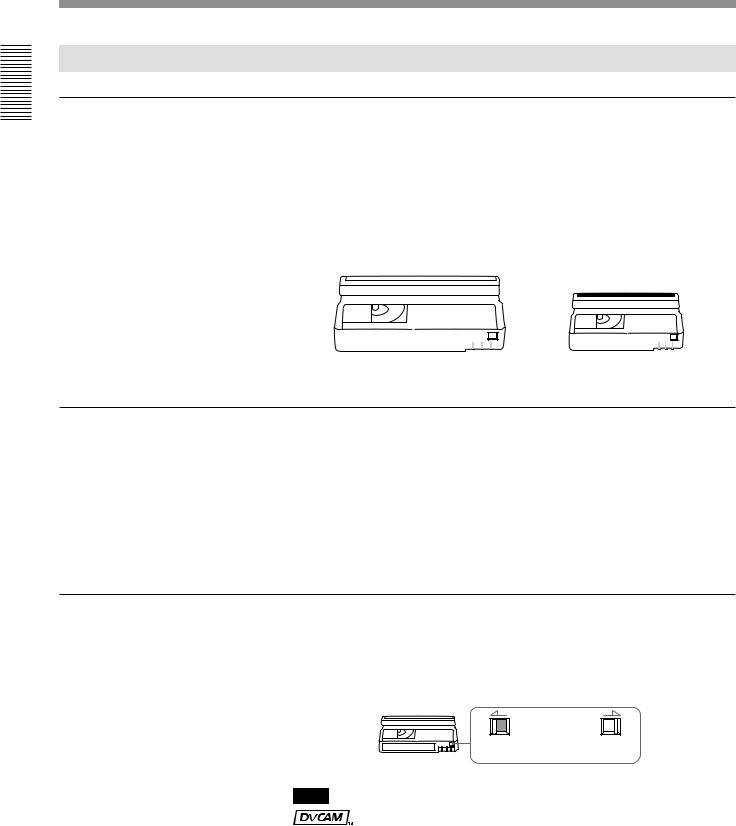
Overview 1 Chapter
Features
Notes on Video Cassettes
Usable cassettes
Use Standard-DVCAM cassettes or Mini-DVCAM cassettes with this VCR. PDV-184ME can record programs for 184 minutes and PDVM40ME can record for 40 minutes.
You can get the highest quality pictures with this digital video cassette recorder using DVCAM cassettes. You may not be able to get as good quality with other cassettes. We recommend using DVCAM cassettes so that you can record your one-time events in highest quality.
|
|
|
|
|
|
|
|
|
|
|
|
|
|
|
|
|
|
|
|
|
|
|
|
|
|
|
|
DVCAM cassette |
|
|
|
|
|
|
Mini DVCAM cassette |
||||||||||||||||||||
Cassette memory
Cassette memory is an optional feature that is mounted on some Standard DVCAM cassettes and Mini DVCAM cassettes. When you record a program, the recording date and time, and the programs’ position on the tape are stored in the cassette memory so that you can quickly locate the program later on. 


 indicates that you can use the cassettes 16 kbits of data can be stored on. On this VCR, you can use the cassettes up to 16 kbits of data can be mounted on.
indicates that you can use the cassettes 16 kbits of data can be stored on. On this VCR, you can use the cassettes up to 16 kbits of data can be mounted on.
To save a recording
To prevent accidental erasure of a recording, slide in the safety switch on the cassette so that the red portion becomes visible. To record on a tape, slide out the switch so that the red portion is hidden.
Write protected |
Write enabled |
Note
,  ,
, 

 and
and 
 are trademarks.
are trademarks.
8EN |
Chapter 1 Overview |
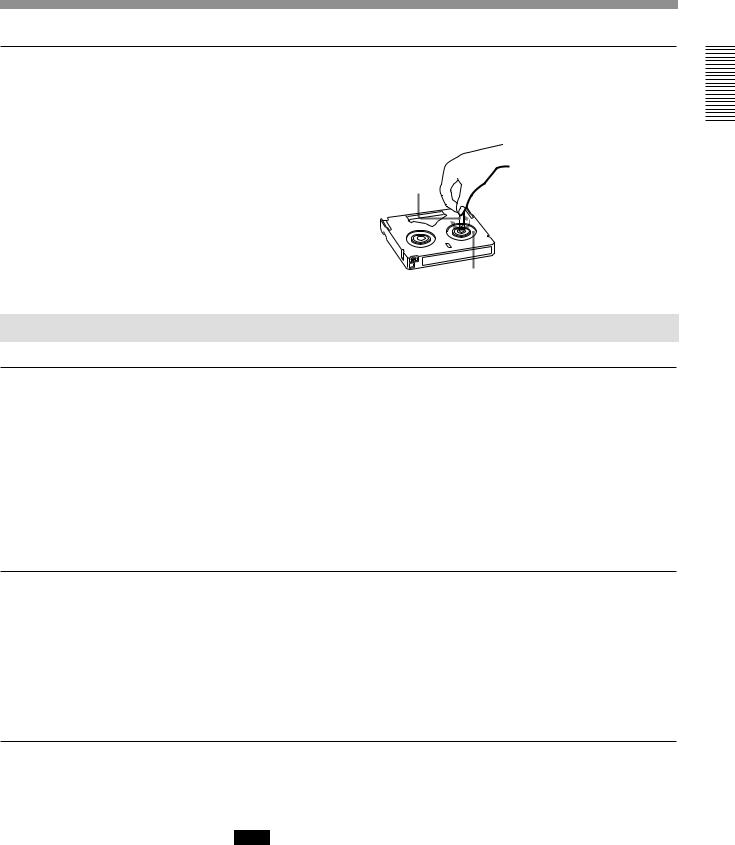
Checking the tape for slack
Using a paper clip or a similar object, turn the reel gently in the direction shown by the arrow. If the reel does not move, there is no slack. Insert the cassette into the cassette compartment, and after about 10 seconds take it out.
Paper clip, etc.
Reel
Notes on Recording / Playing
Copyright precautions
On recording
You cannot record any software having copyright protection signals on this VCR. If you start recording protected video and audio signals, a warning message appears on the monitor screen and the VCR stops recording.
On playback
When you play back software having copyright protection signals on this VCR, you may not be able to copy it onto other equipment.
Limitations caused by the difference in format
This VCR can record, play back and edit the tapes recorded in DVCAM format. It can also play back the tapes recorded in DV format (SP mode). However, due to the difference in format, you may not be able to record or edit some tapes affected by recording conditions of the tape (e.g., A tape originally recorded in DV format is dubbed in DVCAM format). For details, refer to “Compatibility of DVCAM and DV format” on page 41.
No compensation for contents of the recording
Contents of the recording cannot be compensated for if recording or playback is not made due to a malfunction of the VCR, video tape, etc.
Note
You cannot play back a DVCAM tape recorded in other color systems on this VCR.
Overview 1 Chapter
Chapter 1 Overview |
9EN |
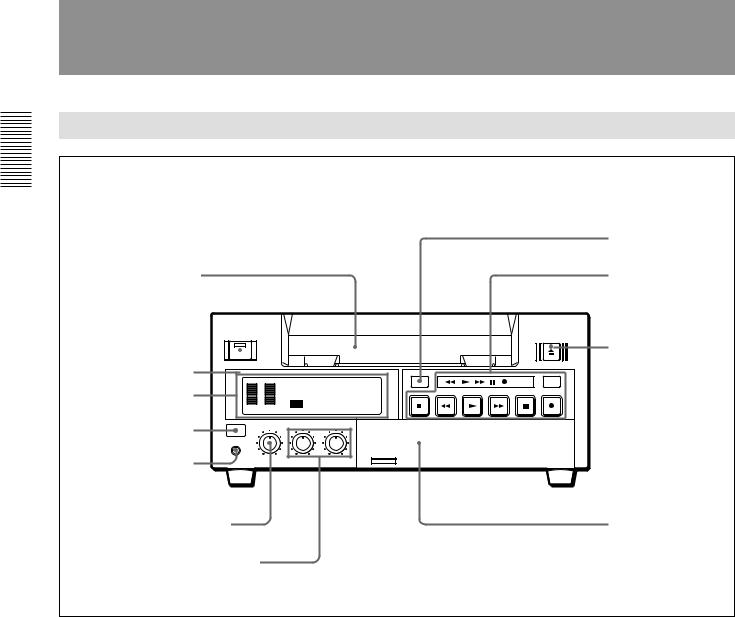
LocationLocationand Functionand Functionof Parts of Parts
Front Panel
Overview 1 Chapter
1 Cassette compartment
2 ON/STANDBY switch
1Display section (see page 7)
3 Remote sensor
4 PHONES connector
5 PHONE LEVEL control knob
6 AUDIO INPUT LEVEL control knob
7 COUNTER RESET button
2Tape transport control section (see page 8)
8 EJECT button
|
|
|
|
|
|
DUP |
|
INPUT |
COUNTER |
AUDIO |
TIMER |
|
|||
SELECT |
|
MONITOR |
REMOTE |
||||
SELECT |
TC |
CH-1/2 |
REPEAT |
||||
MENU |
|||||||
COUNTER |
|
MIX |
|
OFF |
|||
|
TAPE |
CH-3/4 |
|
REC |
LOCAL |
||
|
REMAIN |
|
|
|
|
||
|
|
|
|
|
|
SET |
|
3Inside of the door
(see page 9)
1 Cassette compartment
Accepts standard-size or mini-size DVCAM digital videocassettes. When using a mini-size cassette, insert it into the middle of the compartment.
For details of usable cassettes, see page 4.
2 ON/STANDBY switch
3 Remote sensor
4 PHONES connector (stereo minijack)
Connect stereo headphones for headphone monitoring during recording or playback.
The audio signal you want to monitor can be selected with the AUDIO MONITOR switch inside of the door (3).
5 PHONE LEVEL control knob
Controls the volume of the headphones connected to the PHONES connector.
6 AUDIO INPUT LEVEL control knobs
When recording, you can use these knobs to set audio input levels for CH-1 (channel 1) and CH-2, respectively.
7 COUNTER RESET button
Press this button to reset the tape counter in the display window to “0:00:00 (0H00M00S)”. This button does not work when displaying the time code or the remaining time.
8 EJECT button
10EN Chapter 1 Overview
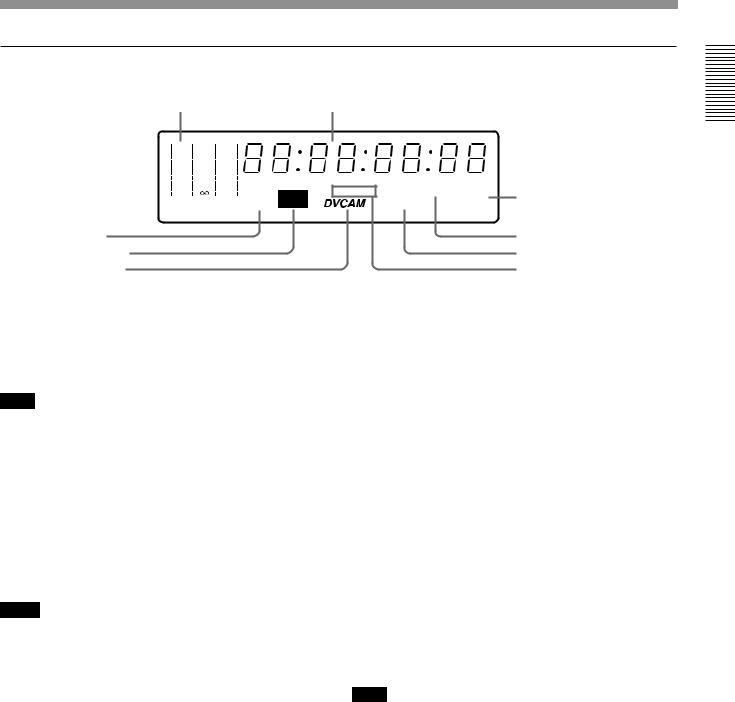
1 Display section
|
|
|
|
|
|
1 Audio level meter |
|
2 Time counter display |
|
||||||||||||||
|
|
|
|
|
|
|
|
|
|
|
|
|
|
|
|
|
|
|
|
|
|
|
|
|
|
|
|
|
|
|
0 |
|
|
|
|
|
|
|
|
|
|
|
|
|
|
|
|
|
|
|
|
|
|
|
|
|
|
|
|
|
|
|
|
|
|
|
|
|
|
|
|
|
|
|
|
|
|
|
|
|
|
|
|
|
|
|
|
|
|
|
|
|
|
||
|
|
|
|
|
|
|
6 |
|
|
|
|
|
|
|
|
|
|
|
|
|
|
|
|
|
|
|
|
|
|
|
|
|
|
|
|
|
|
|
|
|
|
|
|
|
|
|
|
|
|
|
|
|
|
|
|
|
|
|
|
|
|
|
|
|
|
|
|
|
|
|
|
|
|
|
|
|
|
|
|
|
|
|
|
|
|
|
|
|
|
|
|
|
|
||
|
|
|
|
|
|
|
12 |
|
|
|
|
HOURS |
MINUTES |
SECONDS |
|
|
FRAMES |
|
|||||
|
|
|
|
|
|
|
|
|
|
|
|
|
|
||||||||||
|
|
|
|
|
|
|
|
|
|
|
|
|
|
||||||||||
|
|
|
|
|
|
|
|
|
|
|
|
|
|||||||||||
|
|
|
|
|
|
|
24 |
|
|
|
|
|
|
|
|||||||||
|
|
|
|
|
|
|
|
|
|
|
|
||||||||||||
|
|
|
|
|
|
|
|
|
|
|
|
||||||||||||
|
|
|
|
|
|
|
|
|
|
|
|
|
|
TIMER |
|
|
|
|
|
|
|
||
|
|
|
|
|
|
|
|
|
|
|
|
|
|
|
|
|
|
|
|
|
|
||
|
|
|
|
|
|
|
– |
|
|
|
|
|
|
|
|
|
|
NS AUDIO |
|
|
INPUT DV |
3 Video input signals |
|
|
|
|
|
|
|
|
|
|
|
|
Mini |
|
|
|
|
||||||||
|
|
|
|
|
|
|
|
|
|
|
|
|
|
|
|
|
|
|
|
|
|
||
|
|
|
|
|
CH 1/3 |
CH 2/4 |
|
|
|
|
|
|
Fs32k Fs48k |
|
|
S VIDEO |
indicators |
||||||
|
|
|
|
|
|
|
|
|
|
|
|
|
|
|
|
|
|
|
|
|
|
|
|
9 Mini indicator |
|
|
|
|
|
|
|
|
|
|
|
|
|
|
|
4 NS AUDIO indicator |
|||||||
8 Cassette |
|
|
|
|
|
|
|
|
|
|
|
|
|
|
|
|
|
|
5 Audio mode indicators |
||||
indicator |
|
|
|
|
|
|
|
|
|
|
|
|
|
|
|
||||||||
7 DVCAM |
|
|
|
|
|
|
|
|
|
|
|
|
|
|
|
|
|
6 TIMER indicator |
|||||
indicator |
|
|
|
|
|
|
|
|
|
|
|
|
|
|
|
||||||||
|
|
|
|
|
|
|
|
|
|
|
|
|
|
|
|
|
|
|
|
|
|
|
|
1 Audio level meter
Indicates the recording level during recording or EE mode1) and the playback level during playback. When the audio level exceeds 0 dB, the red indicator lights.
Note
4 NS AUDIO indicator
Lights when the VCR plays back a tape whose audio recording was made in the unlock mode, or when unlock mode signals are input through the DV terminals.
For details of unlock mode, see page 41.
If you play back the tape whose audio was only recorded on channel 2, the audio level meter for CH2/4 may not function.
2 Time counter display
Indicates the following:
•Time data: count value of the time counter, time code and remaining time
•Alarm messages (see page 36)
•Messages for self-diagnosis function (see page 39)
Notes
•For DSR-20P: Time code is set to the non drop frame mode only.
•Time code is indicated as follows:
Drop frame: “00:00.00:00” (“00:00,00:00” on the monitor) (DSR-20 only)
Non drop frame: “00:00:00:00”
3 Video input signals indicators
Indicates the currently selected video input signals. INPUT VIDEO, INPUT S VIDEO or INPUT DV lights.
5 Audio mode indicators
Indicates the audio mode during playback or recording or while in EE mode.
•During playback it indicates the audio mode in which the tape was recorded.
•During recording or while in EE mode, it indicates the currently selected audio recording mode. You can select audio recording mode by setting “AUDIO MODE” menu (see page 34).
Fs32k: Lights when playing the tapes recorded in 4-channel mode, or recording a tape in 4-channel mode.
Fs48k: Lights when playing the tapes recorded in 2-channel mode, or recording a tape in 2-channel mode.
Note
When recording in 4-channel mode on this VCR, audio signals are recorded only in channels 1/2.
6 TIMER indicator
Lights when setting the TIMER switch to REPEAT or REC.
7 DVCAM indicator
Lights when using the DVCAM-formatted tapes or recording a tape on DVCAM format.
........................................................................................................................................................................................................
1)EE mode
“EE” stands for “Electric to Electric”. When in this mode, the video and audio signals that are input to the VCR’s recording circuitry do not pass through any magnetic conversion circuits but instead are output via electric circuits only. This mode is used to check input signals and adjust input levels.
Overview 1 Chapter
Chapter 1 Overview 11EN
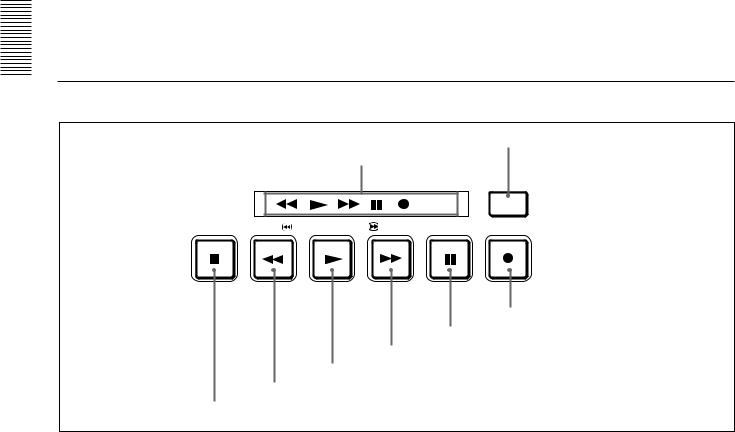
Overview 1 Chapter
Location and Function of Parts
|
|
8 Cassette indicator |
9 Mini indicator |
Lights when inserting a digital video cassette available |
Lights when inserting mini-size digital video cassette. |
for this VCR. It flashes when ejecting a cassette. |
|
2 Tape transport control section
2 DUP button
1 Tape Transport indicators
DUP DUP
STOP REW |
PLAY |
F FWD PAUSE |
REC |
3 REC button
4 PAUSE button
5 F FWD button
6 PLAY button
7 REW button
8 STOP button
1 Tape Transport indicators
2 DUP (duplicate) button
Use this button to make a work tape having the same time codes as the source tape.
For details of duplicate, see page 30.
3 REC (record) button
When you press the PLAY button while holding down this button, the indicator lights and recording begins. To set the VCR to recording pause mode, press this button while holding down the PAUSE button.
4 PAUSE button
When you press this button, the indicator lights and the VCR is set to pause mode.
5 F FWD (fast forward) button
When you press this button, the indicator lights and the tape is fast forwarded. During fast forward, the picture does not appear on the monitor (you can see the picture of the EE mode during fast forward).
To search forward, press this button again during fast forward.
6 PLAY button
When you press this button, the indicator lights and playback begins.
If you press this button while holding down the REW button during stop, the tape is rewound to its beginning and starts playing automatically (during rewind, the REW indicator lights and the PLAY indicator flashes).
7 REW (rewind) button
When you press this button, the indicator lights and the tape starts rewinding. During rewind, the picture does not appear on the monitor (you can see the picture of the EE mode during rewind).
To search backward, press this button again during rewind.
If you press the PLAY button while holding down this button during stop, the tape is rewound to its beginning and starts playing automatically (during rewind, the REW indicator lights and the PLAY indicator flashes).
8 STOP button
Press this button to stop the current tape transport operation.
12EN Chapter 1 Overview
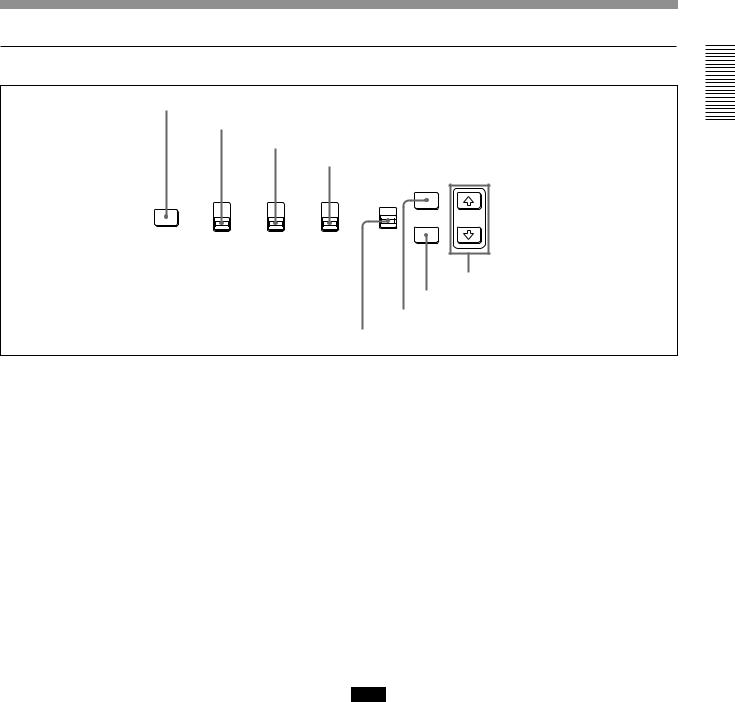
3 Inside of the door
1 INPUT SELECT button
2 COUNTER SELECT switch
|
|
|
|
3 AUDIO MONITOR switch |
|
|
|
|
|
|
|
4 TIMER switch |
|
INPUT |
|
COUNTER AUDIO |
TIMER |
|
||
|
SELECT |
MONITOR |
|
|||
|
REMOTE |
|
||||
SELECT |
|
|
|
|
||
TC |
CH-1/2 |
REPEAT |
|
|||
|
COUNTER |
MIX |
|
OFF |
MENU |
|
|
|
TAPE |
CH-3/4 |
|
REC |
|
|
|
REMAIN |
|
|
LOCAL |
|
SET
8 Arrow (˘≥) buttons
7 SET button
6 MENU button
5 REMOTE/LOCAL switch
1 INPUT SELECT button
Select video input signals. Each press of this button cycles through three video signal selection options: video, S-video, and DV input. When you select one of these options, the corresponding indicator in the display lights up.
2 COUNTER SELECT switch
Select the type of time data in the time counter display. TC: Time code
COUNTER: Count value of the time counter TAPE REMAIN: Remaining time
3 AUDIO MONITOR switch
Use to select the audio track you want to hear when playing pack a tape recorded in 4-channel mode (Fs32k).
CH-1/2: Channels 1/2 only
MIX: Channels 1/2 and channels 3/4 (mix) CH-3/4: Channels 3/4 only
4 TIMER switch
Use to select timer recording or auto repeat using an external AC timer (not supplied).
REPEAT: When the power is supplied to this VCR, a tape rewinds to its beginning automatically and playback starts. The VCR repeats the playback from the beginning to the first index (if there is no index on the tape, to the unrecorded portion; if no unrecorded portion, to the tape end).
OFF: Timer is released.
REC: When the power is supplied to this VCR, recording starts.
5 REMOTE/LOCAL switch
Selects whether the unit is operated from its front panel or from external (remote) equipment.
REMOTE : The unit is operated from an editing controller connected to the REMOTE connector on the rear panel. No operation on the front panel works except sliding switches.
LOCAL : The unit is operated from its front panel, from an external equipment connected to the LANC jack on the rear panel, or from a SIRCSsystem remote controller connected to the CONTROL S jack on the rear panel.
6 MENU button
Press this button to display the menu on the monitor screen. Press it again to return from the menu display to the usual display.
Note
If you set the REMOTE/LOCAL switch to REMOTE while the menu display is on the monitor, it returns to the usual display.
On how to use the menu, see Chapter 3 “Menu Settings”.
7 SET button
Press this button to save selected menu items to the unit’s memory.
8 Arrow (˘≥) buttons
Use these buttons to move around the menu items.
Overview 1 Chapter
Chapter 1 Overview 13EN
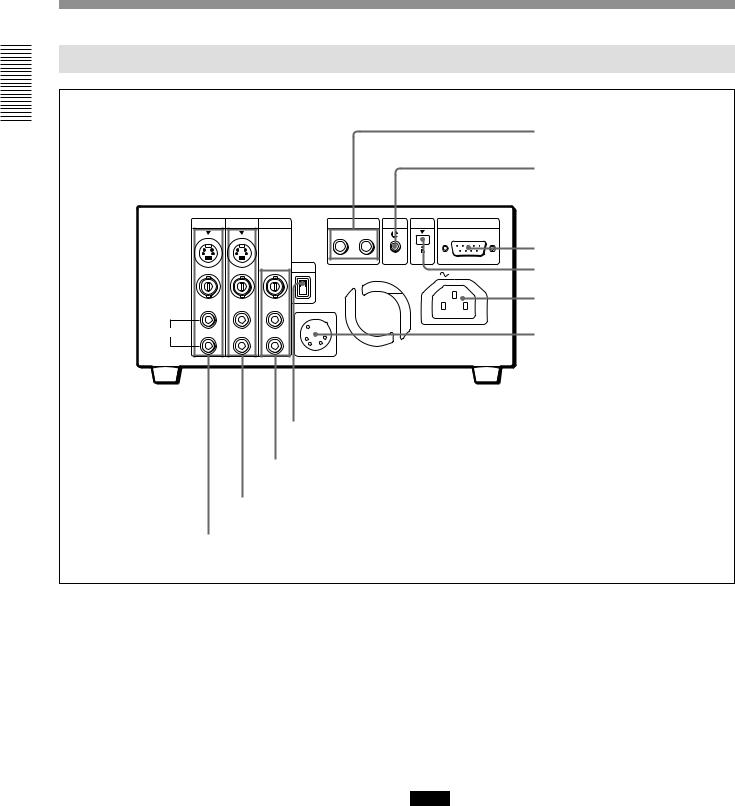
Location and Function of Parts
Rear Panel
Overview 1 Chapter
|
INPUT |
OUTPUT |
MONITOR |
CONTROL S |
LANC |
DV |
REMOTE |
|
|
|
|
|
IN |
OUT |
|
|
RS232C |
S VIDEO |
|
|
|
|
|
|
IN/OUT |
|
|
|
|
|
|
|
|
|
|
|
|
|
|
SYNC |
|
|
|
AC IN |
|
|
|
|
|
|
|
|
|
VIDEO |
|
|
|
INT |
|
|
|
|
|
|
|
EXT |
|
|
|
|
|
|
|
|
|
|
|
|
|
|
|
CH-1 |
CH-1/3 |
CH-1/3 |
DC IN 12V 2.0A |
|
|
|
|
AUDIO |
CH-2 |
CH-2/4 |
CH-2/4 |
|
|
|
|
|
5 CONTROL S jacks
6 LANC jack
7 REMOTE connector
8 DV jack
9 AC IN connector
0 DC IN connector
4 SYNC switch
3 MONITOR jacks
2 OUTPUT jacks
1 INPUT jacks
1 INPUT jacks
Input video and audio signals. To connect a VCR equipped with the S VIDEO OUT jack, use the S VIDEO jack on this VCR.
2 OUTPUT jacks
Output video and audio signals. To connect a VCR equipped with the S VIDEO IN jack, use the S VIDEO jack on this VCR.
3 MONITOR jacks
Output video and audio signals for monitoring.
4 SYNC switch
Selects the reference signal. The video signal is locked to V-sync or H-sync, but not locked to sub-career. The sync phase is not adjusted. The video signal is not locked to DV input.
INT: Selects the playback signal on this VCR as the reference signal.
EXT: Selects the input video signal from the external equipment connected to this VCR as the reference signal.
Notes
•The picture and the sound may be distorted if:
–You set the SYNC switch during playback.
–The analog signal is input from the INPUT jacks during playback with the SYNC switch set to EXT.
•If the SYNC switch is set to EXT during playback, the INPUT SELECT button does not work.
14EN Chapter 1 Overview
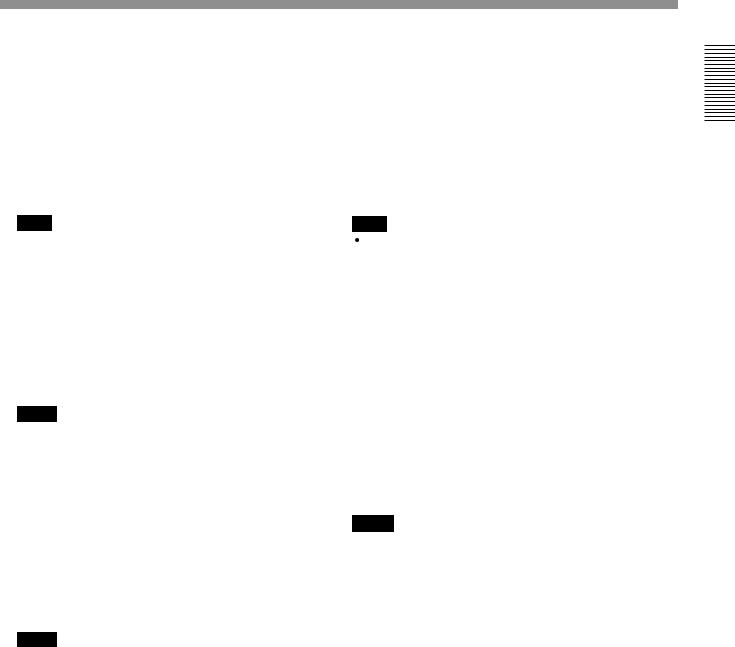
5 CONTROL S jacks
Connect a SIRCS-system remote controller so that you can operate a number of VCRs simultaneously. When controlling this VCR from an editing controller such as the DSRM-10 or SVRM-100A (not supplied), connect the unit to the editing controller via CONTROL S IN jack. Use CONTROL S OUT jack when making a cascade connection.
Note
SIRCS-system has the same function as CONTROL S-system.
6 LANC jack
When you connect the LANC jacks on this VCR and the other VCR, you can control this VCR (player) from the other VCR. The LANC connection transmits signals such as control signals, time code and time counter data and status data.
Notes
•The other VCR (recorder) receives the time code data from the LANC jack only when this VCR (player) is set to show the time code indications.
•If the REMOTE/LOCAL switch is set to REMOTE, the LANC connection does not transmit signals.
7 REMOTE connector (9-pin)
Connect an editing controller or a personal computer with the RS-232C interface for remotecontrol of this VCR.
Notes
•When you edit tapes connecting FXE-120 or FXE100 and using this VCR as a player, set the RS232C baud rate of the both units to 19200bps.
•When you edit tapes connecting FXE-120 or FXE100 and using this VCR as a recorder, use the LANC interface box IF-FXE2.
8 DV jack
The DV jack is i.LINK compatible. Use when the equipment connected to the VCR has a DV jack.
If you connect the VCR and the other equipment using DV jacks, you can minimize deterioration of picture quality during dubbing, editing or capturing still pictures into a personal computer by digital processing. For details, refer to the instruction manual of the equipment you use.
Note
 is a trademark of Sony Corporation and indicates that this product is in agreement with IEEE1394-1995 specifications and their revisions.
is a trademark of Sony Corporation and indicates that this product is in agreement with IEEE1394-1995 specifications and their revisions.
9 AC IN connector
Connect to an AC power outlet using the supplied power cord.
0 DC IN connector
Connect to an DC power source. Use the DC power source whose voltage is 11 - 17 V and electric current is over 2.0 A (4.0 A at the peak).
When the AC power outlet and the DC power source are connected to the VCR at the same time, the latter is automatically selected.
Notes
•If the voltage of the DC power source (e.g., a battery) falls less than 11 V, a beep sound is output (when BEEP in the menu is set to OFF, it is not output) and “dclo” appears in the display window. Replace the battery by a charged one or remove it to use the AC power outlet.
•If the voltage of the DC power source falls less than 10.5 V, a beep sound is output (when BEEP in the menu is set to OFF, it is not output) and the VCR is set to the standby mode. As you cannot turn on the VCR at this moment, replace the battery by a charged one or remove it to use the AC power outlet.
If the voltage falls still less, a circuit works to protect the battery from excessive discharge and the electric current is shut off. As leaving the battery for a long time may cause excessive discharge, remove it.
•Depending on the battery, the VCR may be set to the standby mode again after the circuit works, but it does not mean the trouble of the VCR. Remove the battery.
Overview 1 Chapter
Chapter 1 Overview 15EN
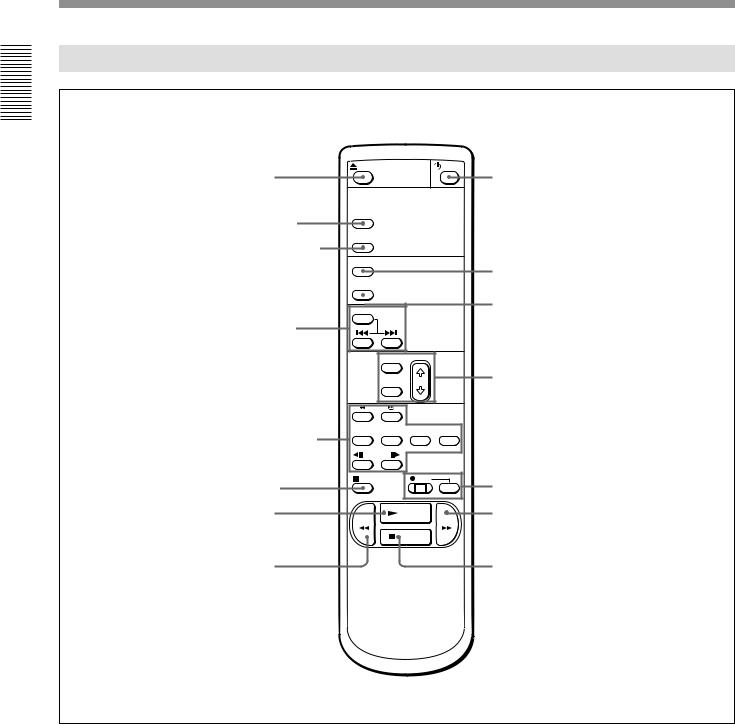
Location and Function of Parts
Supplied Remote Controller
Overview 1 Chapter
1 EJECT button |
EJECT |
|
|
2 COUNTER RESET |
COUNTER RESET |
button |
|
3 INPUT SELECT button |
INPUT SELECT |
|
|
|
DISPLAY |
|
DATA CODE |
|
SEARCH SELECT |
4 SEARCH SELECT |
|
buttons |
|
|
MENU |
|
SET |
5Buttons for playing at various speeds
6 PAUSE button
7 PLAY button
8 REW button
x1/10 |
x1/5 |
x1 |
x2 |
FRAME |
|
|
|
PAUSE |
|
REC |
|
|
PLAY |
REW |
FF |
STOP
9 On/standby switch
0 DISPLAY button
!¡ DATA CODE button
!™ Buttons for menu operation
!£ REC buttons
!¢ FF button
!∞ STOP button
1 EJECT button
2 COUNTER RESET button
3 INPUT SELECT button
4 SEARCH SELECT buttons
Press these buttons to search for scenes using the index function.
For details, see “Searching using the index function” on page 19.
5 Buttons for playing at various speeds
3/#buttons
×1/10 button
×1/5 button
×1 button
×2 button
FRAME “11/7buttons
For details, see “Playing at various speeds” on page 18.
16EN Chapter 1 Overview

6 PAUSE button
7 PLAY button
8 REW button
9 On/standby switch
0 DISPLAY button
Press this button to see the indications, such as tape counter, on the monitor screen.
!¡ DATA CODE button
Press this button to see the tape information on the monitor screen.
For details, see “Displaying tape information” on page 22.
!™ Buttons for menu operation
MENU button SET button ◊/√ buttons
!£ REC buttons
When you press these buttons at the same time, the indicator lights and recording begins.
!¢ FF button
!∞ STOP button
Note
When using the supplied remote commander, set REMOTE CONTROL in the menu to VTR4 (see page 35). Otherwise, you cannot operate this VCR with the supplied remote commander.
Overview 1 Chapter
Chapter 1 Overview 17EN

Recording and Playback 2 Chapter
PlaybackPlayback
This section describes the necessary connections, settings and operations to perform playback on this unit. The same settings and operations apply whether you are using the unit as part of an editing system, for dubbing, or as a stand-alone videocassette player.
Connections for Playback
To digital video equipment with DV connector
The video and audio signals are sent with hardly any degradation, enabling high-quality editing. The signal flow is automatically detected so you need not make separate connections for input and output.
Recorder |
|
Player |
|
Other VCR |
Monitor |
This VCR |
|
|
|
||
to the DV |
to the LANC |
LANC |
DV |
jack |
jack |
|
|
|
|
|
IN/OUT |
|
LANC cable (not supplied) |
|
|
|
DV cable (not supplied) |
ç: Signal flow |
|
Notes
•Set DV EE OUT in the menu to OFF (see page 35).
•Audio signals are not output during playing at various speeds.
•With the DV connection, the sound is recorded in the same audio recording mode as that of the source tape. To record in a different audio recording mode from the source tape, use the LINE connection instead.
•With the DV connection, tape information (recording date, camcorder data, etc.) recorded on the source tape is transmitted from this VCR (player). As a result, when you play back a recorded tape and press DATA CODE, the same tape information recorded on the source tape is displayed on the monitor screen. However, contents of the cassette memory are not transmitted. In addition, the time code is newly recorded on the tape on the other VCR, except when copying a tape in Duplicate mode.
•As for the LANC connection, see “Notes for LANC connection” on the next page.
18EN |
Chapter 2 Playback and Recording |

To video equipment without DV jack
Recorder |
|
|
|
|
|
Player |
|||||
Other VCR |
|
Monitor |
This VCR |
||||||||
|
|
||||||||||
|
|
|
|
|
|
|
|
|
|
|
|
|
|
|
|
|
|
|
|
|
|
|
|
|
|
|
|
|
|
|
|
|
|
|
|
|
|
|
|
|
|
|
|
|
|
|
|
|
|
|
|
|
|
|
|
|
|
|
|
to the S-video |
|
INPUT |
OUTPUT MONITOR |
CONTROL S |
LANC |
DV |
||
input jack |
|
|||||||
|
|
|
|
IN |
OUT |
|
|
|
|
S VIDEO |
|
|
|
|
|
|
IN/OUT |
|
|
|
|
|
SYNC |
|
|
|
to the video input jack |
|
|
|
|
|
|
|
|
VIDEO |
|
|
|
INT |
|
|
|
|
|
|
|
|
|
EXT |
|
|
|
to the audio input jacks |
|
CH-1 |
CH-1/3 |
CH-1/3 |
DC IN 12V 2.5A |
|
|
|
|
|
|
|
|
|
|
|
|
to the LANC jack |
AUDIO |
CH-2 |
CH-2/4 |
CH-2/4 |
|
|
|
|
|
|
|
|
|
|
|
|
|
S-video cable (not supplied)
Video cable (not supplied)
Audio cable (not supplied)
LANC cable (not supplied)
Ç: Signal flow
Notes
•When you connect output jacks of the recorder to input jacks of this VCR, select the input correctly to prevent a humming noise.
•Distorted signals (e.g., when played back at a speed other than normal) will not be recorded properly.
•The indications displayed on the monitor screen are output only via MONITOR jack.
Notes for LANC connection
•The LANC connection transmits signals such as control signals, time code, time counter data and status data.
•If the other VCR has a LANC jack of 5-pin DIN type, connect with the VK-810 Control L connecting cable (not supplied).
•The jacks labeled CONTROL L have the same function as LANC jacks. The jacks labeled REMOTE may also have the same.
•The other VCR (recorder) receives the time code data from the LANC jack only when this VCR (player) is set to show the time code indications.
2 Chapter
ybackPla
andRecor2Chapter
dingPlaybackad Recording
Chapter 2 Playback and Recording |
19EN |

Recording and Playback 2 Chapter
Playback
Settings for Playback
Preparation on the player (this VCR)
1 Power on the video monitor, then set the monitor’s input switches according to the input signals from the recorder.
2 Set up the recorder.
For details, see “Preparation on the recorder” below.
3 Power on this unit by pressing the ON/STANDBY switch.
4 If the other equipment that controls this VCR has the time code function, set the COUNTER SELECT switch to TC (see page 9).
5 When you play back an audio dubbed tape, set the AUDIO MONITOR switch to MIX (see page 9). Then select the precise balance between the tracks with the AUDIO MIX BALANCE in the menu (see page 34).
Note
With the DV connection, the playback VCR’s AUDIO MONITOR (sound selection) and AUDIO MIX BALANCE (audio balance adjustment) do not function on the source audio output through the DV jack.
Preparation on the recorder
•Insert a tape for recording.
•Select the formats of video and audio input signal to be recorded.
•Set the LANC mode to M.
Notes
•Editing is not possible with a tape that is copyright protected.
•You cannot use the video equipment that has no LANC mode switch as a recorder.
20EN |
Chapter 2 Playback and Recording |

Playback Procedure
Notes
•When controlling this unit from an editing controller or a personal computer, set the REMOTE/LOCAL switch to REMOTE. When not, set the switch to LOCAL.
•Do not insert the cassette forcibly. The VCR may be damaged.
1 After checking the tape for slack, hold the cassette so that the tape window is facing upward, then insert it into this unit as illustrated below.
For details of checking the tape for slack, see page 5.
The cassette is automatically drawn into the unit.
Mini size
Insert the mini-size cassette into the middle of the cassette compartment.
Standard size
Tape window facing upward
2 Press the PLAY button.
This starts the playback operation.
Recording and Playback 2 Chapter
Chapter 2 Playback and Recording |
21EN |

Playback
Playback Functions
Playing at various speeds
Recording and Playback 2 Chapter
You can enjoy playback functions using supplied remote controller.
Playback options |
Operation |
|
|
|
|
Play at 1/10 of normal speed |
Press × |
1/10 during playback |
Play at 1/5 of normal speed |
Press × |
1/5 during playback |
Play at normal speed |
Press × |
1 during playback |
Play at twice the normal speed |
Press × |
2 during playback |
|
|
|
Play frame by frame |
Press FRAME “11/7 during pause. |
|
|
|
|
To hear the sound during playing at various speeds
If you want to hear the sound during playing at various speeds, set JOG WITH SOUND in the menu to ON (see page 34).
22EN |
Chapter 2 Playback and Recording |

Searching using the index function
Three kinds of search are available on this VCR:
–Searching for the beginnings of recordings: Index search
–Searching for a point on the tape where the recorded date changes: Date search
–Searching for scenes recorded in the photo mode with a digital camcorder: Photo search
Searching in the list
If the tape has a cassette memory, the recordings are listed in the chronologically in the order they were made. You can search using this chronological list.
If the tape does not have a cassette memory, you cannot search for scenes in the chronological order.
1 Press SEARCH SELECT to select the search type: INDEX, DATE or PHOTO SEARCH.
The chronological list appears on the monitor screen.
INDEX SEARCH |
|
|
|
|
|
|
CH |
1 |
2/28/98 |
1:00AM |
12 |
2 |
3/ 7/98 |
12:59PM |
LINE |
3 |
3/11/98 |
3:05AM |
11 |
4 |
5/ 5/98 |
7:00PM |
CAM |
5 |
7/ 3/98 |
10:15AM |
4 |
6 |
10/28/98 |
12:20PM |
106 |
7 |
11/23/98 |
8:30AM |
10 |
8 |
12/20/98 |
12:30AM |
239 |
|
µ |
|
|
|
|
|
|
When selecting INDEX SEARCH (DSR-20)
2 Press =or +to select a recording.
The VCR starts searching and when it locates the recording, begins playback. During Photo search, the VCR pauses.
Recording and Playback 2 Chapter
Chapter 2 Playback and Recording |
23EN |
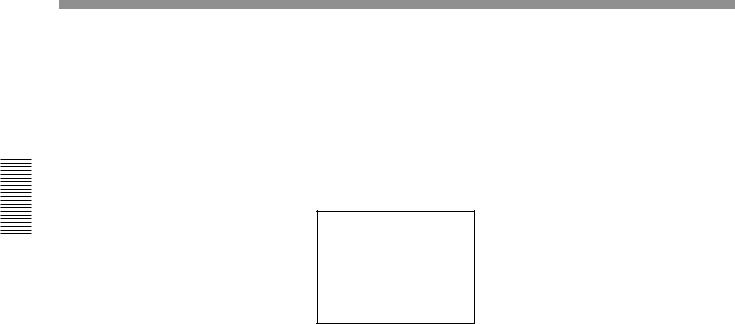
Playback
Recording and Playback 2 Chapter
Searching in the order of the actual positions of the recordings on the tape
When you use a tape without a cassette memory, the VCR searches in the order of the actual positions of the recordings, regardless of the setting of CASSETTE MEMORY SEARCH in the menu.
When you use a tape with a cassette memory, set CASSETTE MEMORY SEARCH in the menu to OFF (see page 35).
1 Press SEARCH SELECT to select the search type.
INDEX 0
SEARCH
When selecting INDEX SEARCH (DSR-20)
2 Press =or +repeatedly to locate the recording you want.
The VCR starts searching backwards or forwards until the index number comes to zero, then plays back the recording. During Photo search, the VCR pauses.
How signals are recorded
The VCR marks the tape when REC is pressed.
There are three different signals for each search method. The type of signal recorded and where it is recorded (on the tape or in the cassette memory) depends on the video equipment used for recording. Please note that if the signals for certain search type are not recorded, you cannot do that type of search.
When you record with a Sony digital camcorder (DSR-200/200P)
Signals for |
In cassette memory |
On tape |
|
|
|
Index search* |
No |
No |
|
|
|
Date search |
Yes |
Yes |
|
|
|
Photo search |
Yes |
Yes |
|
|
|
When you record on this VCR
Signals for |
In cassette memory |
On tape |
|
|
|
Index search* |
Yes |
Yes |
|
|
|
Date search |
No |
Yes |
|
|
|
Photo search |
No |
No |
|
|
|
*The signals for Index search are recorded when you start recording for the first time in stop mode.
24EN |
Chapter 2 Playback and Recording |
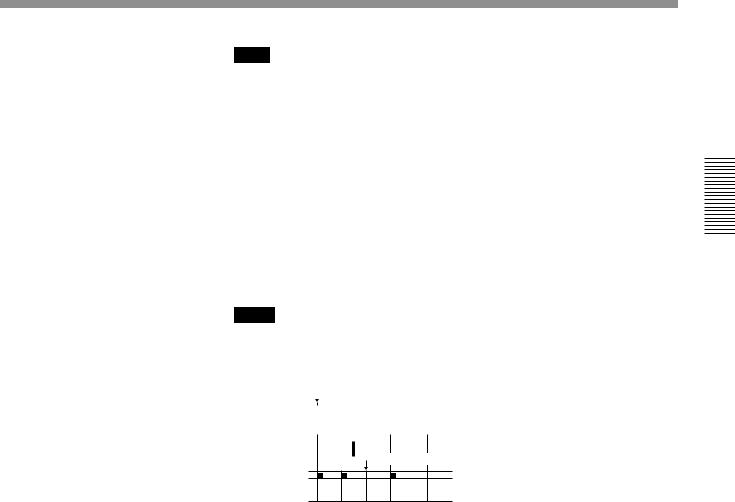
Note
When recording on this VCR, signals for index search do not have information on a day of the week.
About the cassette memory
•If you use a tape with 
 mark, the cassette memory stores up to 135 index signals. (The number changes depending on the data size combination of index, date, and photo data stored on a tape.) This VCR is capable of storing and retrieving up to 16 kbits of cassette memory.
mark, the cassette memory stores up to 135 index signals. (The number changes depending on the data size combination of index, date, and photo data stored on a tape.) This VCR is capable of storing and retrieving up to 16 kbits of cassette memory.
•To locate recordings whose signals are disabled to be stored in the cassette memory, or to locate recordings in order of their position on the tape, set CASSETTE MEMORY SEARCH in the menu to OFF (see page 35). You can use the same procedure to search for a recording on a tape without cassette memory.
Notes
•Each program is indexed at its beginning. If you record another program over the beginning of the first program, you will not be able to locate the original program.
|
|
|
Index signal |
|
|
If D is recorded |
||
|
|
|
|
|
||||
|
|
|
|
|
|
|
|
|
|
|
|
|
|
|
|
|
|
|
A |
|
B |
|
C |
|
||
|
|
|
|
over the beginning of B... |
||||
|
|
|
|
|
|
|
|
|

 B cannot be searched
B cannot be searched
A D B C
•You cannot add indexes after recording.
To add indexes only for Auto Repeat, start recording from the point you want to start indexing.
•You cannot erase indexes after recording.
To delete indexes for Auto Repeat, set INDEX WRITE in the menu to OFF (see page 35). Then record over the index signal you want to erase.
•Searching may not be done correctly if the signals were not recorded on a Sony-brand digital video equipment.
Recording and Playback 2 Chapter
Chapter 2 Playback and Recording |
25EN |
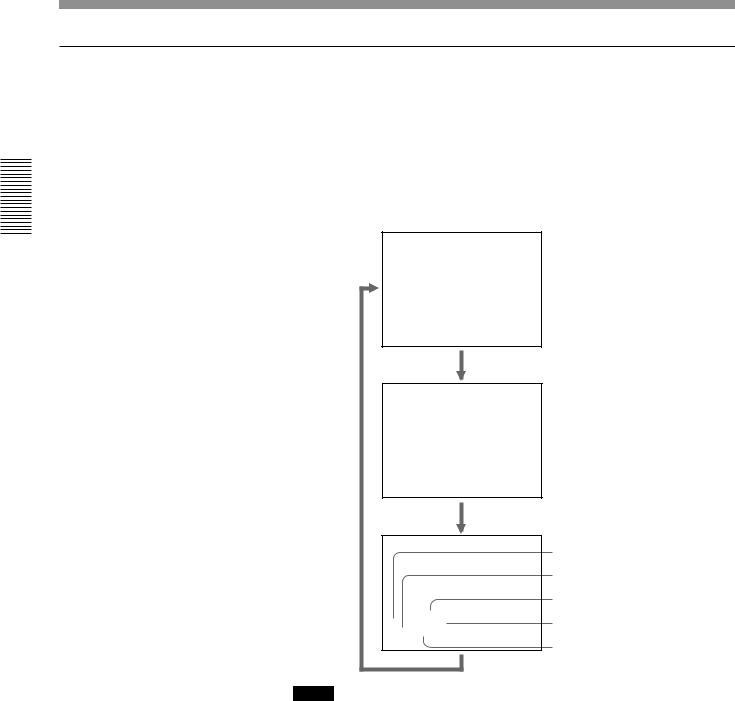
Playback
Recording and Playback 2 Chapter
Displaying tape information
If you record on a tape using a Sony digital camcorder DSR-200/200P, camcorder data (the shutter speed, program AE mode, white balance, iris and gain) can be recorded on the tape. You can check these data during playback on this VCR.
Press DATA CODE during playback.
Each time you press DATA CODE, the display changes as follows.
Data display off
Recording |
|
date and time |
|
1998 / 12 / 25 |
|
12:59 AM LINE |
|
Sony camcorder |
|
settings |
|
|
AWB |
60 |
MANUAL |
F 1.6 |
0 dB |
Shutter speed
Iris
White balance
Program AE mode
Gain
Notes
•When the information was not recorded, “- - -” appears instead.
•The camcorder data displayed on the monitor screen by this VCR are partially different from those shown by the digital camcorder.
26EN |
Chapter 2 Playback and Recording |
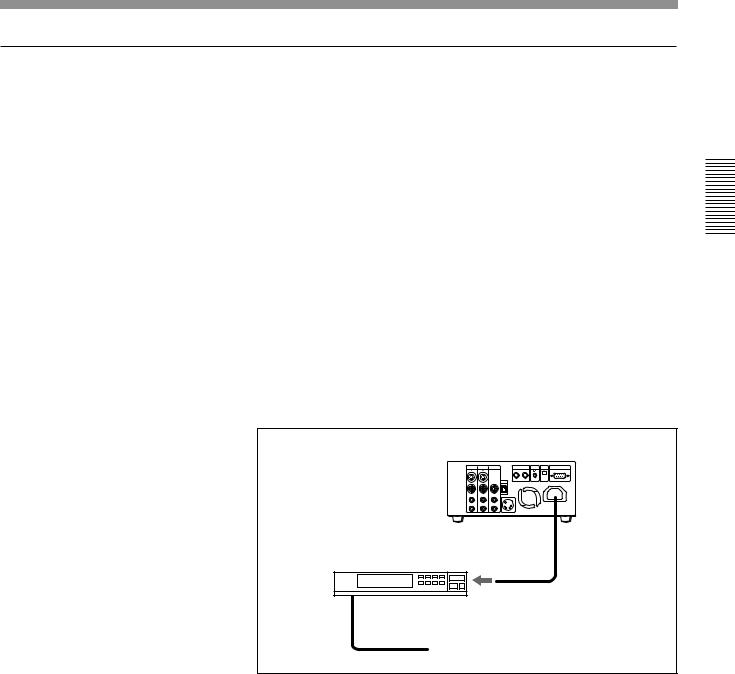
Auto repeat
This VCR can repeat the playback of all or part of the tape.
1 Set the TIMER switch on the front panel to REPEAT.
The TIMER indicator on the front panel lights.
2 Press REW to rewind the tape to its beginning.
3 Press PLAY.
Playback starts automatically. The VCR repeats the playback from the beginning to the first index (if there is no index on the tape, to the unrecorded portion; if no unrecorded portion, to the tape end).
Auto Repeat using an external AC timer
If you connect an external AC timer (not supplied) to this VCR, you can repeat playback automatically at the preset time.
1 Connect an external AC timer (not supplied) to this VCR.
This VCR
AC timer
 to a wall outlet
to a wall outlet
2 Set the TIMER switch on the front panel to REPEAT.
The TIMER indicator in the display window lights.
3 Set the timer-on time on the external AC timer.
At the preset time, the power turns on, and after a few seconds (no more than 30), Auto Repeat playback starts automatically. The VCR repeats the playback from the beginning to the first index (if there is no index on the tape, to the unrecorded portion; if no unrecorded portion, to the tape end).
Recording and Playback 2 Chapter
Chapter 2 Playback and Recording |
27EN |

Playback
Recording and Playback 2 Chapter
Notes
•The VCR cannot search for an index or unrecorded portion within 20 seconds from the beginning of the tape.
•While a tape is running, do not turn off the power, using an AC timer. The VCR and a tape may be damaged. When turning off the power of the VCR, make sure to press STOP on this VCR first to stop the tape transport, then turn off the power.
To stop Auto Repeat
Press STOP.
To release Auto Repeat mode
Set the TIMER switch to OFF.
28EN |
Chapter 2 Playback and Recording |
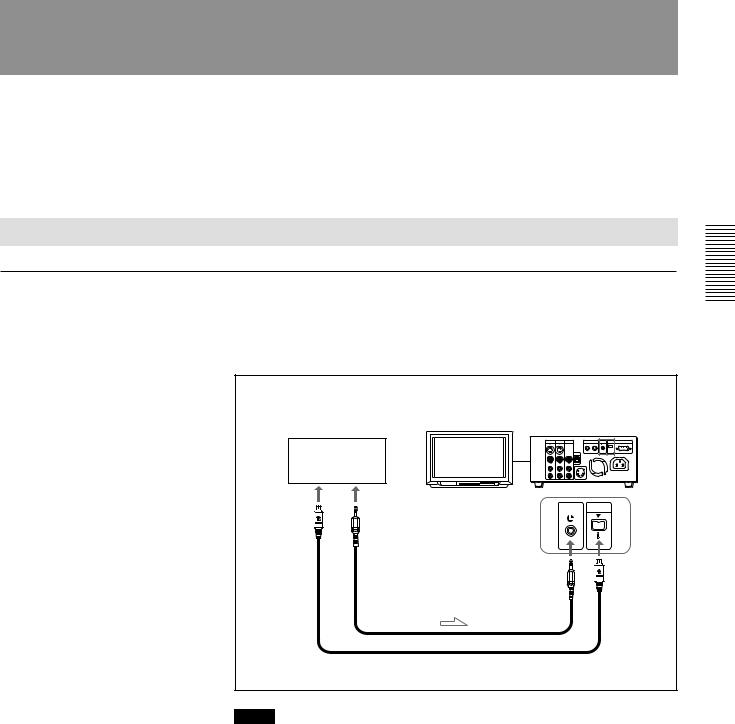
Recording
This section describes the necessary connections, settings and operations to perform recording on this unit. The same settings and operations apply whether you are using the unit as part of an editing system, for dubbing, or as a stand-alone recorder.
Connections for Recording
To digital video equipment with DV connector
The video and audio signals are sent with hardly any degradation, enabling high-quality editing. The signal flow is automatically detected so you need not make separate connections for input and output.
2 Chapter
Player |
|
Recorder |
||
Other VCR |
Monitor |
This VCR |
Playbackand |
|
Recording |
||||
|
||||
|
|
|||
|
|
|
||
to the DV |
to the LANC |
LANC |
DV |
|
|
|
|||
jack |
jack |
|
|
|
|
|
|
IN/OUT |
|
|
LANC cable (not supplied) |
|
|
|
|
DV cable (not supplied) |
|
|
|
|
|
ç: Signal flow |
||
Notes
•Audio signals are not output during playing at various speeds.
•With the DV connection, the sound is recorded in the same audio recording mode as that of the source tape. To record in a different audio recording mode from the source tape, use the LINE connection instead.
•With the DV connection, tape information (recording date, camcorder data, etc.) recorded on the source tape is transmitted from the other VCR (player). As a result, when you play back a recorded tape and press DATA CODE, the same tape information recorded on the source tape is displayed on the monitor screen. However, contents of the cassette memory are not transmitted. In addition, the time code is newly recorded on the tape on this VCR, except when copying a tape in Duplicate mode.
•As for the LANC connection, see “Notes for LANC connection” on the next page.
Chapter 2 Recording and Playback |
29EN |
